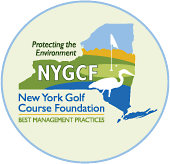3 Planning, Design, and Construction Building a new golf course or renovating an existing one requires careful protection of natural resources during all phases of planning, design, and construction. Implementing BMPs should result in an environmentally sustainable golf course that operates efficiently and cost effectively. BMP Principles for Planning, Design, and Construction Follow best practices anytime soil is disturbed to avoid erosion and Maintain existing habitat to the extent possible during all phases of planning, design, and construction to preserve Manage stormwater by implementing a “treatment train” approach to prevent nonpoint source pollution from runoff. 3.1 Regulatory Considerations Regulations are […]
9 Pesticide Management The storage and handling of pesticides on golf courses presents the greatest risk to water quality contamination because of the potential for an unintended release of a large volume of pesticide resulting in a point source of pollution to surface and/or groundwater. Therefore, the greatest attention to BMPs should be directed at storage and handling. In addition, the potential for pesticide nonpoint source pollution through runoff, leaching, or drift is minimized through proper handling and application. Adhering to pesticide regulations helps to ensure that all proper procedures are followed. For more information on the general use and management […]
11 Maintenance Operations New construction designs should consider combining storage, mixing, and washing operations in an integrated chemical management system. For existing facilities, updating these areas does not necessarily require a new building as many changes can be easily made. Information specific to pesticide storage and handling can be found in the “Pesticide Management” chapter of this document. BMP Principles for Maintenance Operations Assess potential point source pollution risk for maintenance operations. Ensure compliance with regulatory requirements designed to prevent point source pollution. Manage organic and inorganic waste to minimize potential point source pollution. 11.1 Regulatory Considerations Every golf course […]
4 Irrigation Water is a fundamental element for physiological processes in turf such as photosynthesis, transpiration, and cooling, as well as for the diffusion and transport of nutrients. Precise water management is arguably the single most important turf practice for maintaining high quality golf turf. When the amount of water lost from the turf system by evapotranspiration (ET) exceeds the amount supplied by rainfall, the turf must be irrigated. Courses should maximize water use efficiency through proper irrigation, as this conserves water and decreases the likelihood of water quality impacts from runoff or leaching. Deliberate use includes having an efficient […]
10 Pollinator Protection Most flowering plants need pollination to reproduce and grow fruit. While some plants are pollinated by wind, many require assistance from insects and other animals. Most people are aware of managed honey bees, but there are also 450 wild pollinator species in New York State, including bees, wasps, beetles, flies, ants, moths, and butterflies. In the absence of these pollinators, many plant species, including the fruits and vegetables we eat, would fail to reproduce. These include economically important crops in the state, such as apples, blueberries, cherries, tomatoes, squash, and peppers, all of which are pollinator-dependent for […]
1 Introduction The New York State Best Management Practices (NYS BMP) project is an innovative research and outreach education program that has resulted from a partnership of superintendent leaders in the state and Cornell University. Begun in 2012, this project has codified standards and continues to actively demonstrate the implementation of best management practices for the protection of water quality in the state of New York. The success of this work has led to the commitment of superintendents to continue these efforts in perpetuity as part of a sustainable 501(c)(3) non-profit, the New York Golf Course Foundation (NYGCF). As the […]
5 Water Quality Management and Monitoring Aligning water quality management programs, such as stormwater management and lake and pond management with established, research-based BMPs is the first step to protecting water quality. Establishing a water quality monitoring program is the next step. Routine monitoring can be used to measure water quality improvements and identify any areas where corrective actions should be taken. BMP Principles for Water Quality Management and Monitoring Manage lakes and ponds to maintain water quality, avoiding nutrient enrichment and maintaining dissolved oxygen levels. Assess current surface and groundwater quality. Conduct water quality assessments using accepted standards. Use […]
